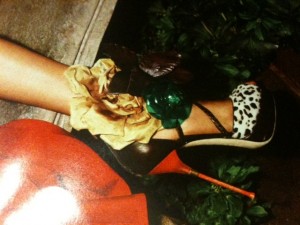People seem to know that I love shoes and trivia. (And a few other things too ;o)
Surprisingly, I have never delved into the history of high-heeled shoes. It’s fascinating. I could write a book about it. Instead of trying to catch you up on six thousand years of shoe history, to quote Joe Friday from the old TV show—Just the facts, just the (interesting) facts ma’am. So enjoy the very brief history of high heeled shoes.
- High-heeled shoes are credited first to the upper class Egyptians, worn by both sexes for ceremonial purposes.
- During the middle ages, both men and women would wear pattens, or wooden soles. Pattens would attach to the expensive shoes of the upper classes, to keep them out of the mud and other street debris.
- Heels grew in popularity during the 1500s to keep horse riders, both male and female, from slipping from the stirrups. The rider’s heel was initially 1 to 1-½ inches high and resembled the modern riding boot and cowboy boot.
- During the 16th century, European royalty started wearing high-heeled shoes to make themselves look taller. A person with authority or wealth was often referred to as “well-heeled”.
- Mid 1600s the Venetians made the chopine/platform shoe into a status symbol indicating wealth and social standing for women. Tourists to Venice often remarked humorously on the outrageously high chopines. (6- 30 inches in height). (And some say I wear tall shoes!) People joked that the chopines were invented by husbands hoping the cumbersome movement would make illicit liaisons difficult. Issues of domination and submission often being associated with heeled shoes much like the lotus shoes of China.
- In the early 1700s, France’s King Louis XIV would often wear intricate heels decorated with miniature battle scenes, called Louis heels. The king decreed that only nobility could wear heels that were colored red. (Forerunner to Louboutin’s?)
- Puritans in the Massachusetts Colony passed a law banning women from wearing the provocative high heels to ensnare a man or they would be tried as a witch.
- In the post-war 1950s Christian Dior and shoe designer Roger Vivier, together developed the narrow heel called a stiletto. An Italian word for a small dagger with a slender, tapering blade. Stilettos were often banned from public buildings because they caused physical damage to the floors
- In the 1960s as feminist movement gained momentum stilettos went out of favor. For many feminists, high heels indicated subservience and sexual stereotyping by men, a comparable successor to foot binding/
- Women now have more shoe choices than ever before. Choosing to wear what they want, even hybrid shoes such as heeled tennis shoes or heeled flip-flops. What is certain is that heels have not disappeared.
- Since the Egyptians high heels have caused a stir. Here are my ridiculous beautiful stiletto status symbol shoes.
History lesson over.
Laura
